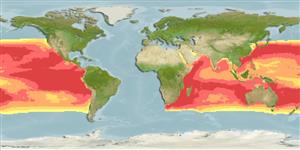Classification / Names
Common names from other countries
Main reference
Size / Weight / Age
Max length : 465 cm FL male/unsexed; (Ref. 40637); common length : 380 cm TL male/unsexed; (Ref. 30573); max. published weight: 750.0 kg (Ref. 5503)
Environment
Marine; pelagic-oceanic; oceanodromous (Ref. 51243); depth range 0 - 915 m (Ref. 43), usually 0 - 200 m (Ref. 43)
Climate / Range
Subtropical; 15°C - 30°C (Ref. 43), preferred 28°C (Ref. 107945); 44°N - 47°S, 18°E - 69°W (Ref. 43)
Distribution
Indo-Pacific: tropical and subtropical waters, occasionally entering temperate waters. Stray individuals migrate into the Atlantic Ocean by way of the Cape of Good Hope, but the existence of Atlantic breeding stocks is unlikely. Highly migratory species, Annex I of the 1982 Convention on the Law of the Sea (Ref. 26139).
Countries | FAO areas | Ecosystems | Occurrences | Introductions
Short description
Dorsal
spines
(total): 0;
Dorsal
soft rays
(total): 39-50;
Anal
spines: 0;
Anal
soft rays: 16 - 21. Body elongate and not very compressed; upper jaw produced into a robust but not very long beak; two dorsal fins, the height of the first less then the greatest body depth, becoming shorter posteriorly; pectoral fins falcate and rigid, with 19 to 20 rays; body densely covered with small, embedded scales with 1 or 2 sharp points; back dark blue; belly silvery white; membrane of first dorsal fin blue black, without spots; flanks without spots (Ref. 55763). Dark blue above, silvery white below; sometimes with light blue vertical stripes; 1st dorsal fin blackish to dark blue, other fins dark brown with tinges of dark blue in some specimens.
IUCN Red List Status (Ref. 115185)
Threat to humans
Harmless
Human uses
Fisheries: commercial; gamefish: yes
More information
ReferencesAquacultureAquaculture profileStrainsGeneticsAllele frequenciesHeritabilityDiseasesProcessingMass conversion
Tools
Special reports
Download XML
Internet sources
Estimates of some properties based on models
Phylogenetic diversity index
PD50 = 1.0005 many relatives (e.g. carps) 0.5 - 2.0 few relatives (e.g. lungfishes)
Trophic Level
4.5 ±0.4 se; Based on diet studies.
Resilience
Medium, minimum population doubling time 1.4 - 4.4 years (K=0.47(?); Fec=67 million; assuming tm>2)
Vulnerability
Very high vulnerability (78 of 100)
Price category
